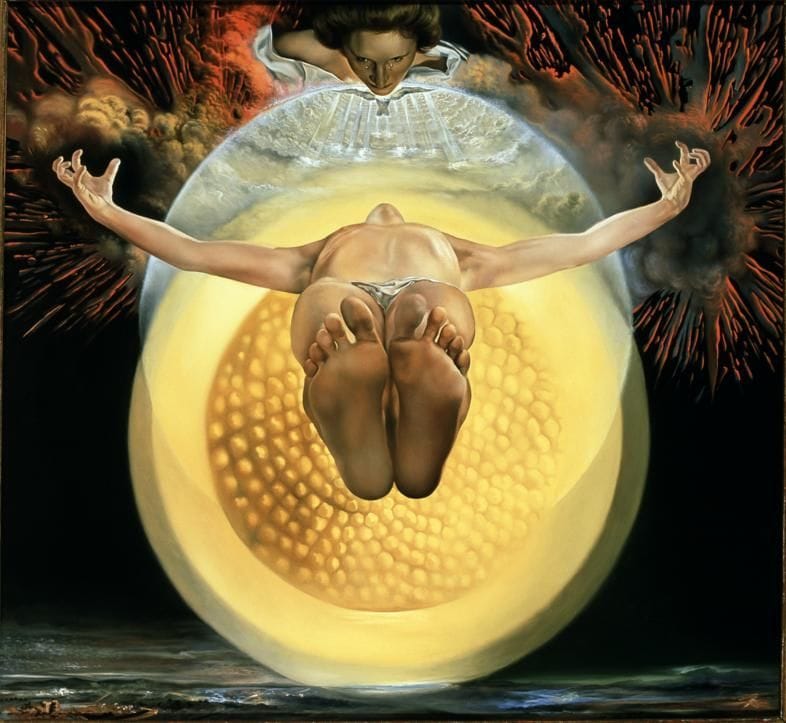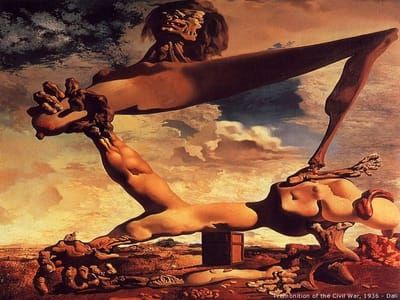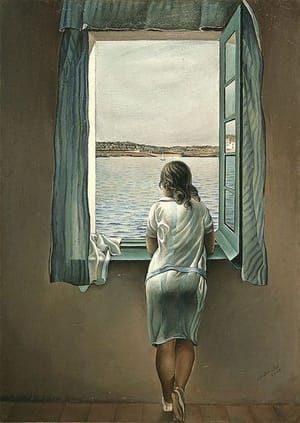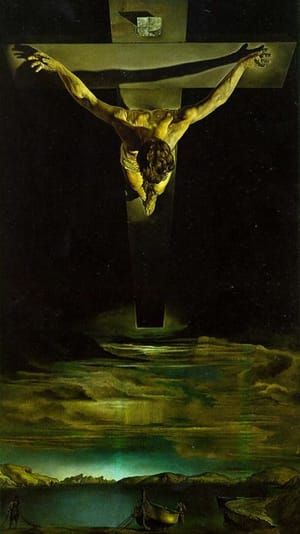

Ascension of Christ, 1958
Salvador Dalí
A
mong the many things Salvador Dali did that one can safely call mind-blowing is how he played with spatial relationships in his paintings.
This man wanted to be remembered as the dean of DIFFERENT!
Think about it. Everything Dali did was counter to “normal.” Of course, anyone expecting normalcy from Salvador Dali was about as wise as the person who tries to thread a camel through the eye of a needle! It’s not going to happen.
So here, in Dali’s stunning 1958 “Ascension of Christ” (sometimes called simply “Ascension”), we have a Dali work that sort of messes with our sense of conventional perspective. Is the image of Christ rising? Is he traveling back into a distant vanishing point? Could he even be descending toward us? Our sense of space, and even time, gets a bit turned on its head here – a hallmark of Dali’s unique vision and perhaps his attempt to confound us a little.
Is the prominence of Christ’s feet suggesting he’s about to set foot on a temporal plain? Or are the feet of Jesus the last thing one would have seen before he ascended toward what is here an electrified sense of heaven? Surely the soiled feet symbolize the walks Jesus made with his Disciples.
So many questions — exactly what Dali intended. He also intended to share with us one of the most important sources of his creative inspiration: his dreams. He had explained that the genesis of this painting came to him one night in a dream, where the nucleus of an atom inspired his sense of “the unifying spirit of Christ.”
Perhaps no other Dali painting, Dali print, or work in other medium – intended to capture the spirit of the artist’s Nuclear-Mysticism period – does so quite as literally as “Ascension.” After all, we have the “nuclear” idea in the cell-like circle that dominates the backdrop behind Jesus, and the “mystical” aura in every other aspect of this large canvas.
One example is how Dali’s wife, Gala – often portrayed as the Holy Mother – mysteriously watches from the heavens, tears shed to perhaps convey the sadness of seeing her son departing the familiarity of the earthly world. Based on how she’s positioned in relation to how Christ is rising, Dali again toys with our perception through perplexing convolutions of space and time.
But the ultimate joy of appreciating great Dali art – any art, really – is that we’re free to float our own interpretation of what the artist meant. Or at least what we think and feel as we consider the work of art. Certainly the large nuclear sphere may also symbolize the sun, which gives life to all. And the florets of a sun flower, arranged in the logarithmic curve by which the mathematically adept Dali was fascinated, are undeniable.
Maybe there’s the suggestion of a sea urchin shell, too – a common element in Dali’s work.
It adds up to what I’m calling the “Dali difference.” He sought to be different because he knew no other way – in art and in life. It is, for me, one of the most fascinating and impressive characteristics of the man: he saw beyond the obvious, dove deeper below the surface, imagined beyond the rational — and beyond the irrational!
(http://www.dali.com/ascension-demonstrates-dali-difference/)
Dali said that his inspiration for The Ascension of Christ came from a "cosmic dream' that he had in 1950, some 8 years before the painting was completed. In the dream, which was in vivid color, he saw the nucleus of an atom, which we see in the background of the painting; Dali later realized that this nucleus was the true representation of the unifying spirit of Christ.
The feet of Christ point out at the viewer, drawing the eye inwards along his body to the center of the atom behind him. The atom has the same interior structure as the head of a sunflower. As with most of Dali's other paintings of Christ, his face is not visible. Above the Christ is Gala, her eyes wet with tears.
The figure of the Christ, from his feet in the foreground to his outstretched arms, forms a triangle. Dali had used the same geometry for his Lapis-lazuli Corpuscular Assumption. He used a triangular structure first in the 1951 painting Christ of St. John of the Crow. The inspiration for this form came from a drawing by Spanish mystic St. John of the Cross, where Christ is depicted as if seen from above.
(https://www.dalipaintings.com/the-ascension-of-christ.jsp)
...Isn’t it amazing how Salvador Dali had this magician-like ability to galvanize our attention on so many levels! In this large, major religious canvas we are almost put in a trance by what’s going on – or what we think is going on – and by how Dali has rendered it so splendidly. Of course, the sheer size and, more importantly, the luminosity and sense of the miraculous in the work transfixes us as we contemplate this at once both beautiful and mysterious work of art.
We see the figure of Christ rising toward an energized, electrifying view of the heavens, guided by and guarded over, it would seem, not necessarily by God – although we might draw that inference overall – but indeed by the figure of Dali’s wife, Gala, peering out from the clouds. A symbol of the Holy Spirit is clearly intended by the dove below her chin, while Gala has been portrayed as Christ’s mother not only here, but in another monumental religious work by Dali: “Corpus Hypercubus” (“Crucifixion”) of 1954. Interestingly, “Ascension of Christ” is subtitled, “Pieta.”
But Dali – master of illusion and of manipulating space and time – throws us off some by the oddly juxtaposed perspectives and points of view in “Ascension.” The Christ figure is seen emerging either backwards or upwards – we don’t know. Meanwhile, it’s less than clear just what plain Gala would be standing on in relation to the angle of the rising Christ. What’s more, we have a more normal and natural field of vision in the landscape shown at the bottom, below the large yellow circle, further confounding our perspective here.
And just what is that brilliant golden sphere? Is it a splitting atom or human cell? Is it the sun? Does it represent the circle of life? Could it be a sea urchin? What we do know is that directly behind the ascending Christ figure are the florets of a sunflower – a natural design by which Dali was intrigued, because its continuous circular pattern follows the laws of a logarithmic spiral – a naturally occurring phenomenon he also found in the horn of a rhinoceros and the morphology of a cauliflower.
The foreshortened view of Christ (whose apparently soiled feet would surely symbolize Christ’s many pilgrimages by foot) was achieved via a glass floor Dali had specially installed in his studio in Port Lligat, Spain, on which he’d position models for various effects....
(https://www.linkedin.com/pulse/art-salvador-dalí-ascension-christ-1958-francisco-filipe-cruz)
Salvador Dalí
artistArthur
Wait what?











